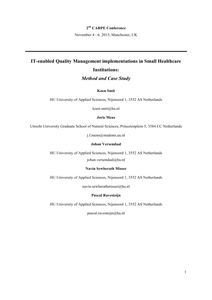Een studente van Technische Bedrijfskunde heeft voor detailgroothandel en distributiecentrum Hoogvliet uit Alphen aan de Rijn de voorbereidingen getroffen en metingen uitgevoerd om de ISO-certificering binnen te halen. Dat is ook binnen 5 maanden gelukt. ISO 50001 gaat over energiemanagement en is een milieu kwaliteitszorgsysteem.
LINK
In the dynamic environment of increasing regulations, increasing patient demand, decentralization of budgets and enforcement of efficiency, small sized healthcare institutions in the Netherlands are having a difficult time. Although these service providers are usually capable of flexibly delivering healthcare, the investment and overhead for implementing and executing on required quality management standards like ISO 9001 is difficult. In this paper we construct a method for the implementation of an IT-enabled quality management system for small sized healthcare institutions, which is applied through case study. The case organisation provides intra- and extramural care for mentally handicapped persons and young adults with a psychiatric disorder. The quality management system implementation is based on 1) a lightweight IT infrastructure (based at a secure data centre and accessible through remote login) implying secure storage of patients' medical and personal information. Furthermore, the Deming (Deming, 1982) cycle enabled processes and protocols are 2) described in an e-handbook and prototyped via an open source process management system which supports the quality regulation demanded for providing care to patients. The case study supports the validity of our method and the fact that small sized healthcare institutions are able to execute their care while adhering to ISO 9001-like standards, with limited initial costs and relatively low cost of ownership
DOCUMENT

De eerste uitgave van deze publicatie is in 1991 samengesteld onder auspiciën van de werkgroep "Kwaliteitsborgingsaspecten bij de vervaardiging van gelaste constructie" ressorterend onder de stuurgroep van het NIL Collectieve Onderzoeksproject "Lassen in de Ketel- en Apparatenbouw". In 2009 is deze publicatie aangepast aan de huidige stand der techniek. De inhoud van deze publicatie gaat in op de verschillende normen ten aanzien van kwaliteitsborging en de warmtehuishouding bij het lassen. Tevens wordt getracht informatie te verschaffen met betrekking tot het hoe en waarom van de "variabelen" die staan vermeld op de lasmethodebeschrijving. Dit laatst genoemde document zal in belangrijkheid gaan toenemen als instrument bij een verantwoord kwaliteitsbeleid. Bij gelaste constructies wordt uitgegaan van een minimum wanddikte van 3 mm.
DOCUMENT

In dit artikel wordt onderzoek over de effecten van ISO van de laatste twintig jaar op een rij gezet. Het is daarbij belangrijk onderscheid te maken tussen de verschillende versies van ISO 1987, 1994 of de meest recente 2000. Het betreft veel case studies met een beperkt bereik of artikelen op basis van beschrijvende statistiek. Als er sprake is van het gebruik van vragenlijsten zijn managers in de meeste gevallen de doelgroep. In een enkel geval kwaliteitsverantwoordelijken. Medewerkers worden slechts zeer beperkt betrokken in de onderzoeken. Aandacht wordt besteed aan de mate waarin ISO in het (hoger) onderwijs voet aan de grond heeft gekregen.
DOCUMENT
Inleidend verhaal over normalisatie in het algemeen en normalisatie met betrekking tot leertechnologieën in het bijzonder. Ook op de NEN-website te vinden.
DOCUMENT

Voor u ligt de voorlichtingspublicatie "Gereedschapsstalen". Deze voorlichtingspublicatie is bedoeld voor allen die te maken hebben of te maken krijgen met toepassing van gereedschapsstalen. Daarbij moet worden gedacht aan bijvoorbeeld constructeurs, lastechnici, werkvoorbereiders, enzovoorts. Deze publicatie is in 1975 samengesteld door een commissie van de FSMG, de Vereniging van Fabrikanten van Stempels, Matrijzen en andere speciale Gereedschappen. In 2008 is de publicatie herzien door TNO Industrie en Techniek. De publicatie VM 48 is er één uit de reeks publicaties over Stempels en Matrijzen voor spaanloze vormgeving van metalen producten. De updating was noodzakelijk daar zich in de afgelopen jaren een groot aantal belangrijke ontwikkelingen heeft voorgedaan op het gebied van gereedschapsstalen.
DOCUMENT

De eerste uitgave van deze publicatie is in 1996 samengesteld door de werkgroep "Dieptrekken van dunne plaat, staal, aluminium" en geeft gerichte theoretische en praktische informatie ten behoeve van respectievelijk de gebruikers van de diverse materialen welke bij het omvormproces (dieptrekken, kraagtrekken, strekken, alsmede buigen en scheiden) worden gebruikt, geïnteresseerden in de betreffende processen, technische cursussen en opleidingen. In 2008 is de inhoud aangepast aan de huidige stand der techniek. De inhoud van deze publicatie behandelt de belangrijkste materialen (zowel product- en gereedschapmaterialen alsmede hulpstoffen) welke bij het vormgeven van dunne plaat van belang zijn. In de voorlichtingspublicaties VM 110 "Dieptrekken", VM 113 "Buigen" alsmede VM 114 "Scheidingstechnieken voor metalen" vindt u gegevens m.b.t. de diverse omvormprocessen en in VM 112 "Machines en gereedschappen" worden de machines en gereedschappen behandeld.
DOCUMENT

Een aantal auteurs uit hogescholen, de organisatie-advieswereld, de Inspectie brengen hun ideeen samen over kwaliteitszorg in het (hoger) onderwijs
DOCUMENT
Recensie van drie boeken over kwaliteit in dienstverlenende bedrijven.
DOCUMENT

Certificering in het Hoger Onderwijs: De medewerking van professionals aan kwaliteitscontrole Dit artikel presenteert de resultaten van een onderzoek naar de bereidheid van professionals in Hogescholen in Nederland en Vlaanderen om mee te werken aan het accreditatieproces. Betoogd wordt dat accreditatie eigenlijk een vorm van certificering is. Conclusies zijn dat professionals loyaal zijn naar hun organisatie en bereid zijn verantwoording af te leggen. De nadruk in de certificering zou dan echter moeten liggen op de inhoud van het werk en de beoordeling zou moeten worden gedaan door vakgenoten (peer review). Er treden meer problemen op bij het certificeringproces, als het management de certificering onvoldoende ondersteunt of als de interne kwaliteitszorg onvoldoende op orde is. Er is een risico dat er window dressing optreedt. Uiteindelijk leidt dat tot de conclusie dat controle (door middel van bijvoorbeeld ISO of HKZcertificering) gescheiden zou moeten worden van verbetering. Er zijn voldoende overeenkomsten tussen hoger onderwijs en maatschappelijk werk om te bezien of de resultaten ook gelden voor maatschappelijk werk.
DOCUMENT
